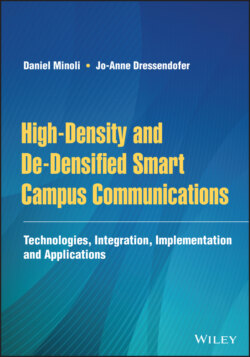Читать книгу High-Density and De-Densified Smart Campus Communications - Daniel Minoli - Страница 39
2.5.1 Downlink Multi‐User MIMO (DL‐MU‐MIMO)
ОглавлениеAs discussed earlier, MIMO systems may use multiple transmit antennas to provide beamforming‐based signal transmission. Typically, beamforming‐based signals transmitted from different antennas are adjusted in‐phase (and optionally amplitude) such that the resulting signal power is focused toward a receiver device. See Figure 2.7. A wireless MIMO system may support communication for a single user at a time or several users concurrently; transmissions to a single user (e.g. a single receiver device) are referred to as Single‐User MIMO (SU‐MIMO), while concurrent transmissions to multiple users are referred to as MU‐MIMO. An AP (e.g. a base station [BS]) of an 802.11‐based MIMO system employs multiple antennas for data transmission and reception; each user STA employs one or more antennas. MIMO channels corresponding to transmissions from a set of transmit antennas to a receive antenna are referred to as spatial streams since precoding (e.g. beamforming) is employed to direct the transmissions toward the receive antenna [20]. A MIMO‐based system provides improved performance (e.g. higher throughput and/or greater reliability) using the additional spatial streams.
FIGURE 2.7 Distributed MIMO communication with beamforming [20].
The 802.11n standard introduced MIMO to the LAN environment, allowing a maximum of four MIMO streams to be transmitted to a WN at a time; 802.11ac increased the maximum (theoretical) number of single‐user MIMO streams received by a WN to eight, effectively doubling the network throughput with 802.11ac compared to 802.11n (note that 802.11ac MU‐MIMO specification defines radio configurations that support up to four simultaneous MIMO channels5).
Specifically, 802.11ac supports MU‐MIMO affording a major improvement over SU‐MIMO (also just called MIMO). See Figure 2.8. This capability is supported in the DL, and the process is known more specifically as DL‐MU‐MIMO. APs typically have four antennas (APs with eight antennas are also available), but most of the client devices are limited to 1–2 antennas; thus, in a SU‐MIMO channel operation, and the full capacity is rarely achieved. For example, a 4 × 4 Wi‐Fi 11ac AP supports a peak PHY rate of 1.7 Gbps. But a smartphone or tablet with one antenna can only support a peak rate of 433 Mbps, leaving 1.3 Gbps capacity of the AP unused – this difference is called the MIMO gap. 802.11ac addresses the MU‐MIMO gap, allowing an AP to support up to four simultaneous full‐rate Wi‐Fi connections (say, 433 Mbps each) where each of these connections is assigned to a different client device such as smartphone, laptop, or tablet. The total bandwidth of 1.7 Gbps is utilized, representing the systems' bandwidth. In this manner, MU‐MIMO improves performance by affording the AP more options to support the BSS clients and enabling the AP to make full use of the total system throughput. In summary, MU‐MIMO provides increased throughput and reduced latency: the efficient use of available spectrum increases the total capacity of a network by a factor of 2×–3×, and since client devices do not time‐share connections with other clients on the network, each device incurs reduced wait time. To achieve the full MU‐MIMO benefit with an 8 × 8 AP would require an 8 × 8 client configuration; unfortunately, this is not practical, especially with mobile devices and limited battery power (typical mobile clients support 1 × 1 or 2 × 2 configuration). The maximum throughputs in the 5 GHz band are:
FIGURE 2.8 SU‐MIMO versus MU‐MIMO.
4 × 4/4‐stream: 1.733 Gbps max rate
3 × 3/3‐stream: 1.300 Gbps max rate
2‐stream 802.11ac: 0.867 Gbps max rate
1‐stream 802.11ac: 0.433 Gbps max rate
As noted, in 802.11ac, only a single‐user WN is allowed to transmit (in the UL direction) at a point in time; multiuser DL transmission from an AP to non‐AP WNs is supported through DL‐MU‐MIMO beamforming. The more WNs active in the network, the longer the stations may need to wait before they are allowed to transmit UL a buffered frame. The issue is improved in the 802.11ax specification.
